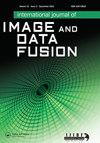Zayandeh-rud河流域植被覆盖变化检测的最优指标:融合方法
IF 1.8
Q3 REMOTE SENSING
International Journal of Image and Data Fusion
Pub Date : 2019-04-27
DOI:10.1080/19479832.2019.1601642
引用次数: 4
摘要
摘要本研究结合15种不同的植被指数,对2001年至2016年Zayandeh-rud河流域的植被变化进行了调查。应用并测试了两个主要计划,以生成最终的植被变化图。在第一个方案中,变化图是通过对原始植被指数进行单独差异来生成的。第二个计划是融合视角,包括两种算法。在第一种方法中,使用多数投票法在决策层融合了从植被指数中获得的变化图。第二种算法包括基于粒子群优化(PSO)的不同植被图的加权组合。结果表明,植被指数之间的高度相关性并不一定能提供相同的结果,应用粒子群算法可以自动组合所有植被指数。尽管基于PSO的组合不能显著提高变化检测,但它解决了为变化检测过程寻找最佳阈值的问题。然而,从植被变化的角度来看,它们都表明,在研究期间,由于Zayandeh-rud河西部的不规则用水,研究区域的植被覆盖率有所增加。本文章由计算机程序翻译,如有差异,请以英文原文为准。
Optimum indices for vegetation cover change detection in the Zayandeh-rud river basin: a fusion approach
ABSTRACT In this study, vegetation changes in the Zayandeh-rud river basin in the period 2001 to 2016 have been investigated based on the combining of the 15 different vegetation indices. Two main plans were applied and tested to produce the final vegetation change map. In the first plan, change maps were produced by differencing the original vegetation indices individually. The second plan, which was a fusion perspective, included two algorithms. In the first one, change maps, obtained from vegetation indices, were fused at the decision level using the Majority Voting Method. The second algorithm included a particle swarm optimisation (PSO) based weighted combination of the different vegetation maps. The results show that the high correlation between vegetation indices does not necessarily provide the same results and combination of all them can be done automatically by applying PSO. Although PSO-based combination could not significantly improve the change detection, it solved the problem of finding optimal threshold value for the change detection process. However, from the vegetation change point of view, they all indicate that during the years of study, the vegetation cover has increased in the study area due to irregular water usage of the Zayandeh-rud river in its western part.
求助全文
通过发布文献求助,成功后即可免费获取论文全文。
去求助
来源期刊

International Journal of Image and Data Fusion
REMOTE SENSING-
CiteScore
5.00
自引率
0.00%
发文量
10
期刊介绍:
International Journal of Image and Data Fusion provides a single source of information for all aspects of image and data fusion methodologies, developments, techniques and applications. Image and data fusion techniques are important for combining the many sources of satellite, airborne and ground based imaging systems, and integrating these with other related data sets for enhanced information extraction and decision making. Image and data fusion aims at the integration of multi-sensor, multi-temporal, multi-resolution and multi-platform image data, together with geospatial data, GIS, in-situ, and other statistical data sets for improved information extraction, as well as to increase the reliability of the information. This leads to more accurate information that provides for robust operational performance, i.e. increased confidence, reduced ambiguity and improved classification enabling evidence based management. The journal welcomes original research papers, review papers, shorter letters, technical articles, book reviews and conference reports in all areas of image and data fusion including, but not limited to, the following aspects and topics: • Automatic registration/geometric aspects of fusing images with different spatial, spectral, temporal resolutions; phase information; or acquired in different modes • Pixel, feature and decision level fusion algorithms and methodologies • Data Assimilation: fusing data with models • Multi-source classification and information extraction • Integration of satellite, airborne and terrestrial sensor systems • Fusing temporal data sets for change detection studies (e.g. for Land Cover/Land Use Change studies) • Image and data mining from multi-platform, multi-source, multi-scale, multi-temporal data sets (e.g. geometric information, topological information, statistical information, etc.).
 求助内容:
求助内容: 应助结果提醒方式:
应助结果提醒方式:


